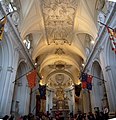
The Capitolium or Capitoline Hill, between the Forum and the Campus Martius, is one of the Seven Hills of Rome.

Giovanni BattistaPiranesi was an Italian classical archaeologist, architect, and artist, famous for his etchings of Rome and of fictitious and atmospheric "prisons". He was the father of Francesco Piranesi, Laura Piranesi and Pietro Piranesi.

Ripa is the 12th rione of Rome, Italy, identified by the initials R. XII, and it is located in the Municipio I.

Piazza Armerina is a comune in the province of Enna of the autonomous island region of Sicily, southern Italy.
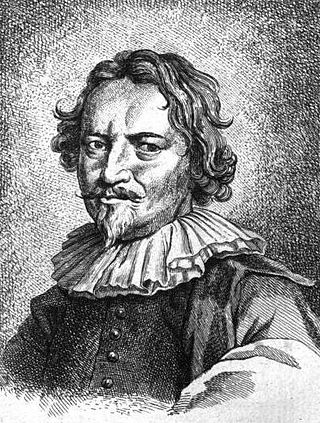
Carlo Fontana (1634/1638–1714) was an Italian architect originating from today's Canton Ticino, who was in part responsible for the classicizing direction taken by Late Baroque Roman architecture.

The Basilica dei Santi Bonifacio e(d) Alessio is a basilica, rectory church served by the Somaschans, and titular church for a cardinal-priest on the Aventine Hill in the third prefecture of central Rome, Italy.
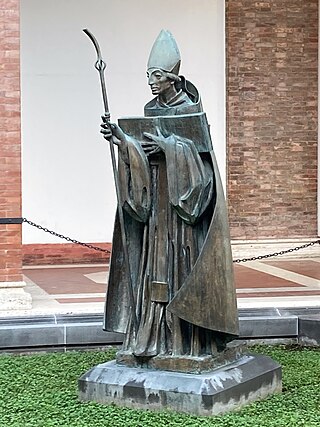
Sant'Anselmo all'Aventino is a complex located on the Piazza Cavalieri di Malta Square on the Aventine Hill in Rome's Ripa rione and overseen by the Benedictine Confederation and the Abbot Primate. The Sant'Anselmo complex, also known as the "Primatial Abbey of Sant'Anselmo" because it is the residence of the Abbot Primate, consists of: an ecclesiastical residential college known as the "College of Sant'Anselmo" ; a university known as the "Pontifical Athenaeum of Saint Anselm" ; the "Church of Sant'Anselmo" ; and the curial headquarters of the "Benedictine Confederation" and Abbot Primate. The complex and associated institutions are named in honor of the Benedictine monk Saint Anselm of Canterbury.

San Nicola in Carcere is a titular church in Rome near the Forum Boarium in rione Sant'Angelo. It is one of the traditional stational churches of Lent.

Charitable institutions attached to churches in Rome were founded right through the medieval period and included hospitals, hostels, and others providing assistance to pilgrims to Rome from a certain "nation", which thus became these nations' national churches in Rome. These institutions were generally organized as confraternities and funded through charity and legacies from rich benefactors belonging to that "nation". Often, they were also connected to national scholæ, where the clergymen of that nation were trained. The churches and their riches were a sign of the importance of their nation and of the prelates that supported them. Up to 1870 and Italian unification, these national churches also included churches of the Italian states.

Villa del Priorato di Malta or Magistral Villa, located on the Aventine Hill in Rome, is one of the two institutional seats of the government of the Sovereign Military Order of Malta. Along with Magistral Palace, the estate is granted extraterritorial status by Italy. It also hosts the Grand Priory of Rome and the embassy of the Sovereign Order of Malta to Italy.
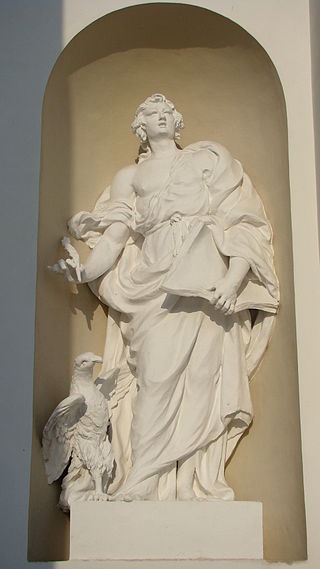
Tommaso Righi (1727–1802) was an Italian sculptor and stuccator with a practice in Rome. His marble and stucco funeral monument to Carlo Pio Balestra, patron of the Church of Santi Luca e Martina, in the Roman Forum, is probably his most prominent commission. His monument of cardinal Camillo Paolucci stands in a chapel of San Marcello al Corso, where its design was constrained by its having to form a pendant to the baroque monument facing it, of Fabrizio Paolucci, by Pietro Bracci (1726). A great work, less often seen, is his altarpiece in the Church of S. Maria del Priorato, the chapel of the Villa of the Sovereign Military Order of Malta: Piranesi provided the design, and Righi executed the great globe surrounded by putti in clouds, and Saint Basil in Glory supported by two angels. His bas-relief panel appears among a host by others, in the central Sala degli Imperatori of the Galleria Borghese, part of the rearrangement of the interiors of the Villa Borghese undertaken in 1782 by prince Marcantonio Borghese.

Carlo Francesco Bizzaccheri was an Italian architect. He worked in a Baroque and early Rococo style.

Santo Stefano dei Cavalieri is a church in central Pisa located on Piazza dei Cavalieri.

San Giovanni Battista dei Cavalieri di Rodi is a church in Rome, on piazza del Grillo in the Monti district. Its full title is the Palatine Chapel of Saint John the Baptist of the Knights of Rhodes.

The Casa dei Cavalieri di Rodi is a building in Rome. Sited in the ruins of the Forum of Augustus, it was built by the Knights Hospitaller at the end of the 13th century and since 1946 has been used by their successors, the Sovereign Military Order of Malta.
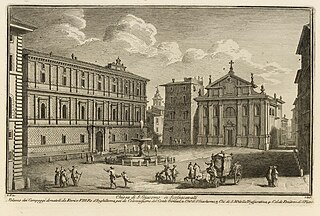
San Giacomo Scossacavalli was a church in Rome important for historical and artistic reasons. The church, facing the Piazza Scossacavalli, was built during the early Middle Ages and since the early 16th century hosted a confraternity which commissioned Renaissance architect Antonio da Sangallo the Younger to build a new shrine. This was richly decorated with frescoes, painted by mannerist artist Giovanni Battista Ricci and his students. The church was demolished in 1937, when Via della Conciliazione was built and the piazza and central part of the Borgo rione were demolished. Many decorative elements still exist, since they were preserved from demolition.
Giovanni Battista Rezzonico was an Italian cardinal of the Catholic Church.
The Association of Italian Knights of the Sovereign Military Order of Malta brings together the Knights and Ladies of the Sovereign Military Order of Malta of Italian nationality. It was founded in 1877 in Rome, it is currently based at the Casa dei Cavalieri di Rodi in the Piazza del Grillo, Rome.

San Giovanni di Malta, also known as San Giovanni del Tempio or San Giovanni dei Furlani, is a Roman Catholic church in the Castello sestiere of Venice, Italy, dedicated to John the Baptist. It is believed to have been established by the Knights Hospitaller sometime after 1187, although it is sometimes linked to the Knights Templar. The present building was constructed between 1498 and 1505, and it is located adjacent to a priory. The property was taken over by the state in 1806 and the church was closed in 1810, but in 1841 it was handed over to the Sovereign Military Order of Malta, who reopened the church in 1843.





